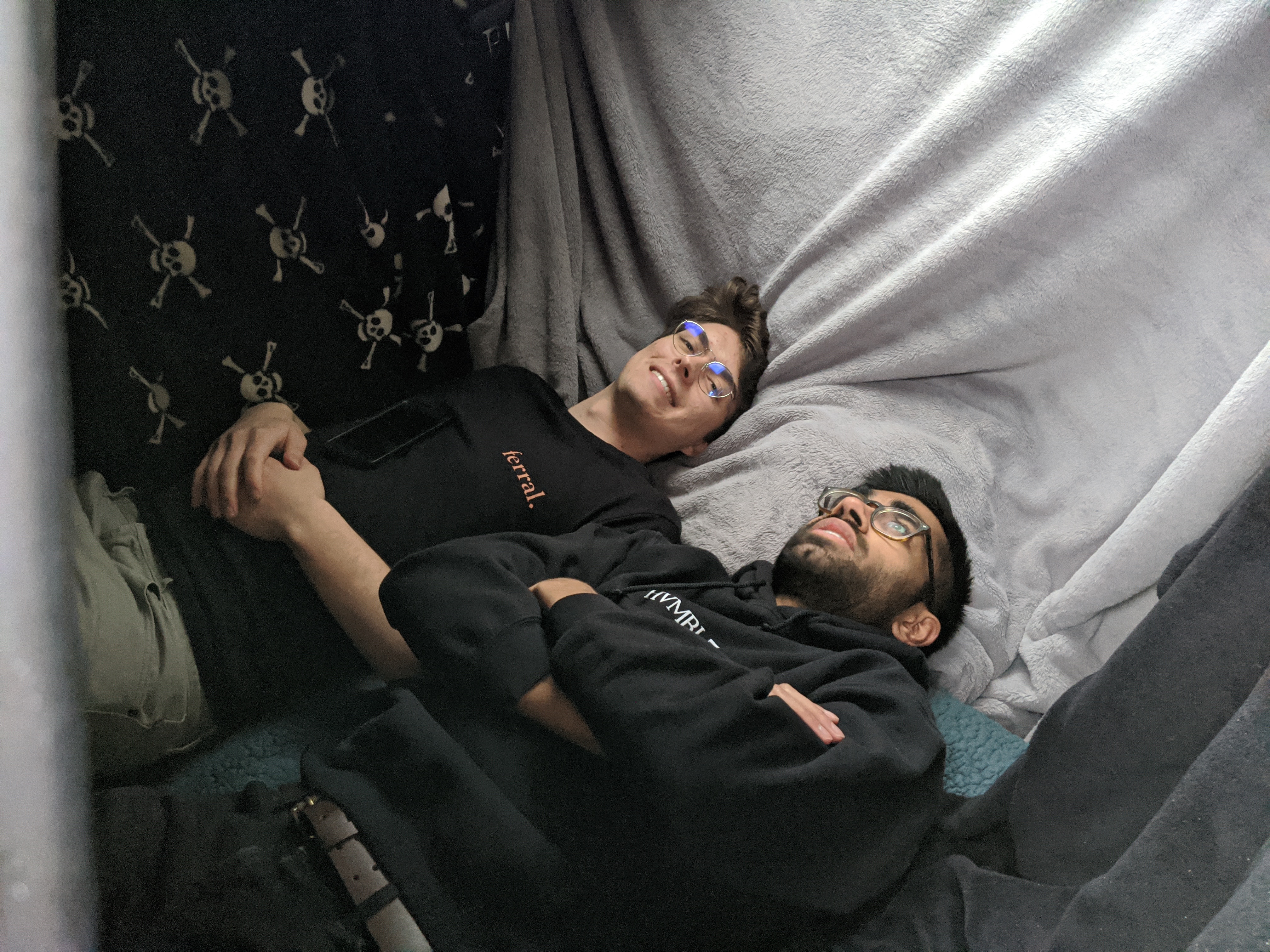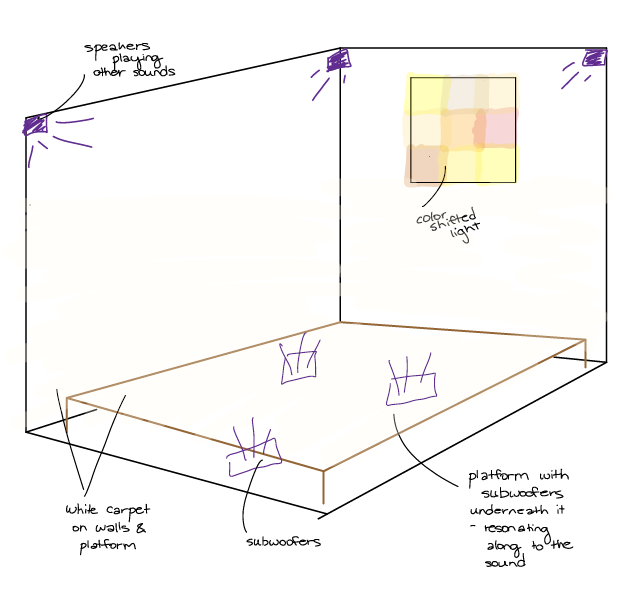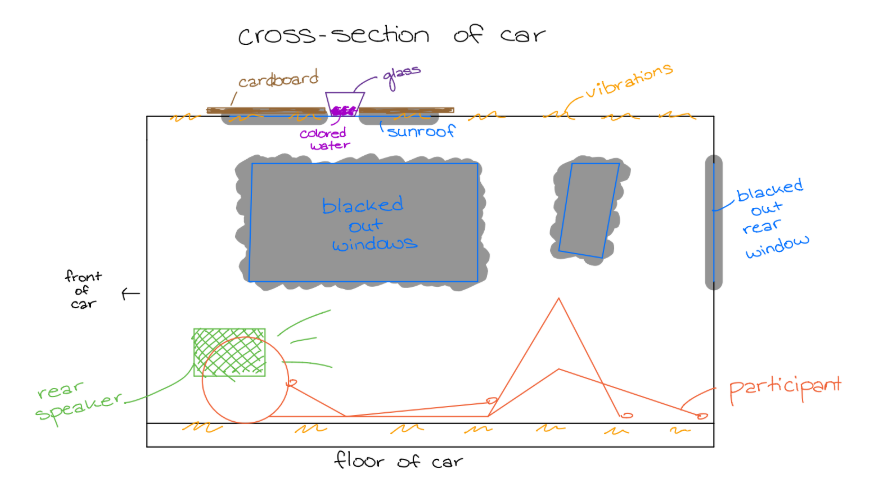Introduction
The Oneness is an installation sound piece that is inspired by the transience and change that our world is
currently experiencing. While every individual’s situation is unique, the common human feelings produced by
these global transitions bind people together across boundaries of physical space. The Oneness experience
comprises a sound composition that is played in a special environment. Its goal is to promote similar mental and
physical reactions in people regardless of how disparate their mental states are upon entering the Oneness. It
is intended to bring the participants to the present and make them focus on their body/physical senses; bringing
them first more viscerally into themselves and then into the surrounding world once the piece ends.
The sound composition is an eight minute long combination of overlapping and interwoven layers of various sine
frequencies, which change in intensity and tone throughout the piece. Other sounds are played and layered onto
the sine waves during the piece to help shift the mood of the experience. The loud, repetitive sounds are meant
to be mesmerising, carrying the participant on a journey to relaxation.
The Oneness itself is installed in the back of a hatchback car, using easily obtainable household materials so
that any person can recreate the physical experience in a vehicle of their own. The seats in the back of the car
are laid flat to be flush with the trunk floor, creating a large flat space, which is covered with blankets. The
car is blacked out using blankets tucked into the windows, handles, and other parts of the car. The only source
of light comes from colored water sitting on the sunroof of the car.
The sound composition is played over the car speakers, so the resulting vibrations resonate through the car,
shaking the floor, walls, and roof. The participants, lying on the blankets, feel the sound all along their
bodies. As the participants shift and touch different parts of the car, their experience alters as the
vibrations coming through different structures/materials sound and feel different. Since the roof of the car is
vibrating, the water on the sunroof moves along with the frequencies, casting the moving light around the cabin.
The participants are completely enveloped in the sound: feeling, hearing, and seeing the frequencies, hopefully
bringing oneness with both themselves and our shared surroundings.
Installation
The installation was set up in this Honda Fit. The front seats were pushed all the way up towards the front of the car with the backs leaned forward as much as possible. A blanket was held in place by both front windows and tucked into the sun visors. This blanket eliminated light from the windshield and hid the dashboard, steering wheel, and automotive controls.
More blankets were held by the rear passenger windows and the trunk/hatchback door. The small blind spot side windows were covered with cardboard that was cut to shape and secured with tape. A blanket covered the flat cargo area for comfort, and another blanket (checkered blanket in picture) was bunched up at the front as a head rest.
The sunroof was covered with cardboard that has a circular cutout in the middle, just big enough for a purple plastic IKEA bowl. In the bowl was purple liquid, dyed with food coloring, letting less light into the cabin and making the light that does enter more purple. The liquid was retained inside the container by plastic wrap taped across the top. The bowl itself was taped inside the cardboard hole. The entire apparatus was secured to the top of the car with tape.
.jpg)
The bottom of the sunroof was then completely dark except for the purple spot. The car wasn't level, which had an unintended, but welcome, side effect. The colored water was deeper on one side of the bowl than the other, causing a color gradient across the bowl. This cast purple and pink light onto the blankets inside, as seen above.

This view shows the back of the car, if the participant were to look down towards their feet.

When lying down, the participants put their head underneath the sunroof. The car can comfortably fit two people in this layout.
Testimonials
“The low frequency took me out of my thoughts and made me not think about where I was. Then the high frequencies came in and my thoughts would reset.”
“The visuals changed throughout the piece as my eyes adjusted to the surroundings, spending more time in the car made me have a deeper experience.”
“I became more and more tense as the tempo increased, then when it became constant there was a sense of relief.”
“The sounds, specifically the rumbling, made the car alive.”
“I felt completely at the mercy of the experience, completely floating along with it.”
“I went in and out of thinking about my day or whatever, but would continually be brought back into my body and the sound throughout the piece.”
“Over time my body became in sync with whatever was happening and I started to get relaxed and lulled by the sound.”
“My sense of time was altered and I got lost in the sound. When the door opened at the end I suddenly remembered where I was and was brought back to the present.”
“[This experience] really made me focus on my body a lot and then I took in the world around me much more than before after stepping out.”
“This made me go into my internal thoughts/internal self. I feel more retrospective now. It made me wonder how different or similar the experience is for other people.”
“...It seems like what a space pod would be.”
“Felt like the bottom of a boat, the motor alive with the water sounds.”
“The rapidly changing frequencies made me feel alert and focused.”
“I didn’t want to leave….wanted to stay in there at the end.”
“It was hard to think about anything but the sounds while I was in there.”
DIY
If you want to experience this installation for yourself, it is easy to put together in any car. Find all the blankets you can get your hands on in your house and work on tucking and clamping them over/in all the windows.
If you have a hatchback you can put the seats down so multiple people can lie down. If not, the back seat can fit one person lying down at a time.
You can download the audio (section below). Play the audio over your car speakers, turning the volume up as much as you are comfortable with (louder is better). If you have bass controls in your car, try playing with the settings to get the most vibrations in the car.
If you have a sunroof, you can find a colored container or put some food coloring in water in a clear container. Try to cover the rest of the sunroof as best you can; cardboard works well but rags or folded blankets would also work well. If you don’t have a sunroof, just try to black the car out as much as possible.
If you don’t have a car or don’t want to set up the full installation, you can still download the sound piece and listen on headphones or good speakers. The better the speakers/headphones, the more you will “feel” the piece. A quality sound system will be able to partially recreate the tactile sensations of the car’s vibrations. I also recommend listening while lying down and closing your eyes.
Audio
Below is the eight minute audio composition. You can listen in the browser or download it for later use.
Enjoy :)
Inspiration
“In Harmonicity, The Tonal Walkway” by Julianne Swartz 2016
This exhibition, which is currently on display at MASS MoCA, has speakers integrated into a walking bridge. The speakers play 24 specific tones recorded by different people. These specific tones with associated vocal qualities are supposed to evoke specific emotions. So as you walk down this pathway you are exposed to the different tones and “mental effects” as you travel through. From this piece, I took inspiration from how seamlessly integrated the speakers and sound was into the space.
“Dream House” by La Monte Young and Marian Zazeela 1993
Dream House is an entire apartment in New York City that has been transformed into an otherworldly space of sound and light. As you move through the house you experience new mediums of art as the sound and light melds together. From this installation I gained inspiration for how to implement art as a living thing; to completely envelop people and transport them to a new mental space.
“Perfectly Clear” by James Turrell 1991
This work is one of his “Ganzfeld” pieces that makes the viewer lose all depth perception, completely removing them from the physical space they are in. I tried to emulate James Turell’s masterful transformation of a space with lighting.
“Cross Cut” by James Turrell 1998
Another of Turrell’s, this piece is one of his “wedgeworks” where he lights a space to look like it has walls and barriers where there are none. What I love about his installations are that they make you stop and think; you get completely absorbed by the work. It takes time to appreciate his pieces and you’re rewarded when you do so as you uncover more the longer you look. The lighting in my installation was heavily inspired by the feelings his works inspire.
“Candlelight” by Spencer Finch
This installation by Finch recreates the exact light cast by a candle inside a room by color shifting the outside sunlight. I am inspired by his ability to transform the feeling of a space in such a simple way. This work inspired me to use natural light in my own installation.
Updates

The original plan was to have the installation take up a full room and be semi-permanent art exhibit; taking
some
effort to install and take down. There was still going to be color shifted light, and the entire room would have
been
padded with white carpet. There would have been a temporary floor built in the room with subwoofers attached to
the
bottom side of the platform, causing the participant to feel the vibrations of the sound waves from the floor.
There
would have been speakers hung from the ceiling playing the non-sine-wave sounds, creating a more directional
piece.
When we had to leave campus, I lost access to a room to permanently set up the exhibit and the access to the
expensive
speakers I needed to successfully execute the project.

However, I realized that my car has good surround sound speakers that shake the car when bass plays. So the
current
iteration of the installation formed.
The largest change is the permanence and access to the installation. In the original, it would have been
accessible
most times of the day; looping the sound piece. However, this was not possible given the current situation so the experience became much more transient. People experienced it not on
their own
terms, but when I had the availability to set it up and they couldn’t stay in there for as long as they desired.
However, this abrupt start and end to their exposure with the installation added an element of shock which, I
now
believe heightened the effects of the piece. There was no time to mentally prepare or investigate, so the
conversations
and thoughtfulness after was more necessary to unpack the experience.
Artist
Aurora Bunten is a senior at Olin College of Engineering, graduating with a degree in Mechanical Engineering this May. The Oneness has been a huge learning experience for her; expanding her skills of not only the technical aspects of audio composition but also of engaging and grappling with the meaning and outcomes of art. She enjoyed the iterative process of slowly, continually improving the project over the semester and how small changes can have a large impact. She hopes that people at home will feel inspired to recreate the experience.